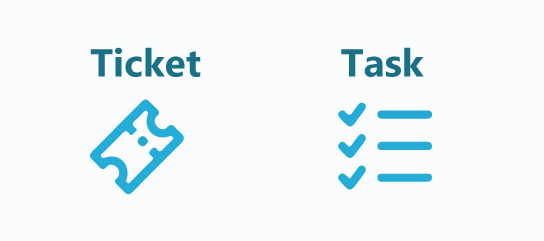OneDesk allows you to create tickets and tasks and gives you the ability to create workflow automation for each. Both tickets and tasks are entered into OneDesk through one of five channels: email, chat, import, manual add, or webforms. You can use OneDesk’s workflow automation tool to automate actions on both tickets and tasks.
Tickets and Tasks in OneDesk
Tickets and tasks behave virtually the same; whatever you can do with a task, you can also do with a ticket. They are both work items and have the same functionality. This means you can capture a ticket and a task in the same ways through the five channels, and they both have workflow automation capabilities, statuses, and more.
However, tasks and tickets have some differences.
1. Visually, each has its own dedicated icon that you will see used throughout the OneDesk application.

2. Tickets and tasks have their own dedicated application, which can be accessed by clicking on their respective icons from the left-hand bar.
![]()
3. Each has its own administrative section under which you can configure its functionality to better suit your preferences.

Why Different Applications for Tasks & Tickets?
So why does OneDesk have separate applications for tasks and tickets?
Generally, best practices suggest that you handle customer requests in the tickets application and that you assign planned work in the tasks application. That means that tickets are reserved for handling customer communications while tasks are kept for work that needs to be planned out. That’s why out-of-the-box, OneDesk comes with planned schedules on tasks but not on tickets. It creates a more efficient and less-cluttered work environment.
While both tasks and tickets function the same, it’s best you use them for their intended purposes: tickets for customer communications and tasks for planned work.